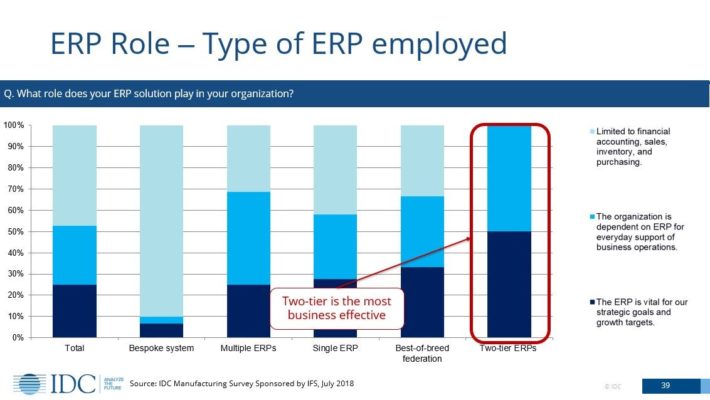When a business should consider a TWO-TIER ERP STRATEGY
Today’s ERP landscape is mature, with most companies having implemented some level of ERP solution. However, many larger companies still find themselves in the situation where their existing solution cannot deliver on all the business requirements across its group of companies.
 This situation isn’t something that was necessarily planned for and arises for many reasons:
This situation isn’t something that was necessarily planned for and arises for many reasons:
- Acquisitions of smaller companies—where the corporate global ERP is complex or too expensive then companies may feel that a manufacturing arm will not be best-served economically and/or functionally by the global solution.
- Mergers—where it is not practical to change the solution of either company.
- Organizational diversity—not all the group companies have the same business requirements so one solution does not fit all.
- Speed—an ERP solution is required quickly to satisfy a business need and the global solution would not be implementable in that timescale due to complexity or capability.
- Location—many smaller companies are situated at sites that do not have access to good communications networks, so cloud-only solutions are a problem and a different on-premise ERP solution would be better.
- Change—the business changes its manufacturing requirements which cannot be satisfied economically or functionally by the global ERP solution.
- Strategy—the choice of solution was biased towards one part of the organization and the desire for global consolidation, accounting and commercial activities override the needs of the manufacturing business
Changing ERP strategies
Companies that are struggling to provide adequate divisional solutions with their existing ERP will need to adopt a different ERP strategy. Fortunately, there are many options:
- ‘Rip and Replace’—an unlikely and very costly strategy as investment in ERP solutions is both expensive and time consuming, and not something a business would simply abandon.
- Plugging the big holes—simply put, this strategy involves implementing only the parts of the global solution that are mandatory, leaving many processes manual or managed by spreadsheet. This is an ineffective solution that is very inefficient and a significant barrier to a digital transformation strategy.
- Bespoke—there are many bespoke ERP solutions still successfully running businesses today, however many are poorly documented and rely on knowledgeable staff and large IT departments to support them. With the rate of change in technology, plus the plethora of package solutions today, starting with a bespoke strategy would be a very costly and risky choice.
- Multiple ERP solutions—this is not so much a strategy but more “let’s not touch solutions that are already in place”. The main issue with this strategy is the inability to move staff around, managing the consolidation of different data models plus the ongoing cost of managing multiple technologies and their upgrades.
- Adopting Best of Breed (BoB)—BoB has been around for many years but the promise of plug and play solutions that would simply knit together has failed to materialize. Initiatives like CORBA (Common Object Request Broker Architecture) which started in1991 have failed, mainly due to the diverse set of interests of its participants. BoB solutions today tend to be ‘edge’ solutions with simple integrations and data transfers. They often deal with specialist requirements or areas where standards are forever changing or where a compromise using an ERP product just wouldn’t work, examples being EDI, import/export documentation or color mixing solutions
- 2-tier ERP—2-tier ERP provides companies with the ability to run the equivalent of two ERP systems at once: one at the corporate level and one at the division level. A manufacturing company could use an ERP system to manage its global finance and sales operation whilst running lighter more agile ERP solutions within its production facilities.
A recent survey by IDC gave surprising results showing the 2-tier model as being the most business effective.

Advantages and disadvantages
Using a single ERP product across the whole organization without compromising the individual business unit’s efficiency and flexibility is obviously the ultimate solution. This is however, difficult to achieve in many manufacturing companies for all the reasons described earlier. Considering a 2-tier approach maybe the most appropriate strategy. This will be especially true for large organizations with diverse product ranges and markets where the ‘one size fits all’ just delivers compromise and unnecessary cost!
Adopting a 2-tier ERP strategy does have some disadvantage, such as having to deal with more than one provider and will certainly require a level of integration work to be carried out. Weighing up the advantages against the disadvantages is critical to making the strategy successful.
Evaluate your stragegy
Adopting 2-tier ERP strategies should always be considered in any company’s ERP review whether that is related to a change in solution or an upgrade of the incumbent. Understanding what the advantages are and where disadvantages can be alleviated by adopting the right 2-tier ERP model is critical. In my next blog I will discuss these in more detail and propose the best strategy for making it work.
If you enjoyed this blog then please look out for others at IFSBlogs
I welcome comments on this or any other topic concerning process manufacturing.
Connect, discuss, and explore using any of the following means:
- Twitter: @ElkinsColin
- Email: elkins@ifsworld.com
- Blog: http://blog.ifs.com/author/colin-elkins
- LinkedIn: https://www.linkedin.com/in/colinelkins
Do you have questions or comments?
We’d love to hear them so please leave us a message below.
taishadarelene
This is one of the best article in this blog,thanks for sharing information about erp in chrome browser,keep it up…
ERP software development company in chennai
Sarah Smith
Thanks for explaining that if you have a large company with diverse product ranges, you might need to develop a 2-tier ERP strategy. We have a smaller company, but we are selling everything from K-beauty skincare to children’s fashion. I’m not sure which approach would be better for us, so I will start looking for an ERP consulting company.
Rebecca Gardner
It stood out to me when you said that ERP solutions should quickly satisfy the needs of a business. My brother is looking into ways to improve the processes in the small businesses he started earlier this year. I’ll have to let him know that looking into ERP solutions might help him reach his goal sooner.